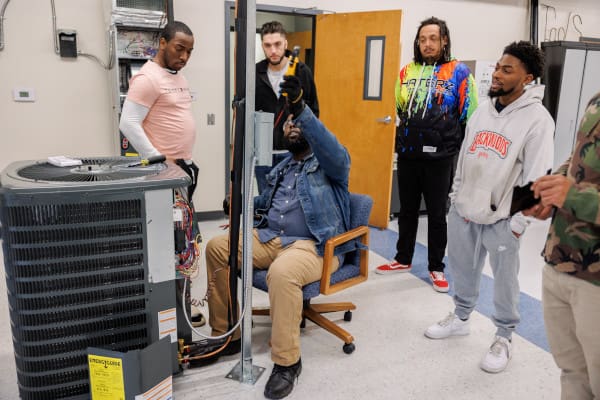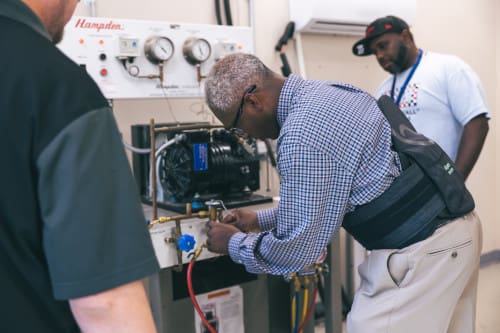
Many have heard the term ‘HVAC,’ but what exactly does it mean? HVAC, or Heating, Ventilation, and Air Conditioning, centers around systems that regulate heated and cooled aired throughout a building. According to the Air Conditioning Contractors of America, the HVAC services market in the U.S. is predicted to increase in value to $35.8 billion in 2030, a large jump from $25.6 billion in 2019, making the role of an HVAC trade school and technician even more vital. Here we take a deeper dive into the industry, trade school and the road to becoming an HVAC technician.
Making Sense of the HVAC Industry
HVAC systems are comprised of three areas: electrical, mechanical and airflow systems. Students enrolled in HVAC training will learn how electricity flows and how to operate the electrical systems used in the HVAC field. This includes developing skills on passing power to a load and utilizing a multimeter to correct a known issue. This knowledge can then be applied to motors, compressors, fan, and other systems.
By way of both lecturing and hands-on training, students receive training in the mechanical functions and general components of compressors, motors and electrical switches. According to Paula Pante-Berrios, an HVAC instructor at Centura College’s Newport News campus, “Our courses provide the ability to connect fan motors and other mechanical components to not only see how they work but also how to troubleshoot any issue.”
Meanwhile, an understanding of airflow is also applied in most HVAC trade school courses. Students will learn the importance of airflow particularly throughout a home while obtaining the skills needed to build and design duct work to allow for proper structural air penetration.
The system is also critical to the operations of refrigeration. By understanding the basics of refrigeration and electrical, students will also better be equipped to learn the operation of a heating system as well, making them more prepared to become a well-rounded HVAC technician.
Learning About HVAC Training
While a normal day in the HVAC training program typically begins with a critical thinking activity of a real-life scenario in the field, it also includes the opportunity to interact with one another, different than that of a standard four-year college classroom. Likewise, visual aids and discussion surround the daily lectures to stimulate deeper thinking and prepare students for real-life scenarios.
Pante-Berrios, who started her HVAC career in the Air Force’s Contingency Response team, says this helps bolster determination in both the students and the instructors in the HVAC training program. She states, “For our students to have the chance to install, troubleshoot, and see the operation of their work is not only building confidence in them, but it is reassuring of us as instructors that we are sending competent technicians into the field.”


Hands-on Training for Technical Skills
For students enrolled in skilled trades, interactive, hands-on learning is a large component that is extremely influential to the future success of their career. Furthering this, findings from the Proceedings of the National Academy of Sciences (PNAS) stated that students in classes with traditional lecturing were 1.5 times more likely to fail than students in classes with active learning. This was derived from their meta-analysis of 225 studies that reported data on examination scores or failure rates comparing student performance.
Students apply what they learn inside the classroom portion of the HVAC training program in the lab to mimic on-the-job training. These range from lessons on wiring electrical boards to installing condensers and air handlers. Before the day is dismissed, students and the instructor will then debrief on everything that was completed and its importance.
Career Sectors for a Skilled HVAC Technician

Upon graduation from an HVAC program, a variety of career options are available. This includes technician roles divided into sectors.
Sectors
Residential
HVAC techs that visit homes to fix problems dealing with air conditioning units and refrigeration equipment are working in the residential sector. A residential HVAC installer typically works with small air conditioning equipment, such as window air conditioner units, portable A/Cs and sophisticated climate control systems such as Ecobee Smart Thermostat Premium or Google Nest Learning Thermostat.
Commercial
The biggest difference between the residential and commercial sectors is the size of the units. Commercial sector HVAC technicians work on buildings like apartment buildings or skyscrapers, which results in the need and maintenance of a much larger unit than that of those found in the residential sector.
Appliance
Many appliances in residential and commercial buildings run on refrigeration systems. An HVAC tech who has their Environmental Protection Agency (EPA) Certification, Section 608 Refrigerant Transition, is qualified to repair equipment that uses refrigerant.
Creating a Career After HVAC School
Graduates of the HVAC program at Centura College can earn critical industry certifications such as the Occupational Safety and Health Administration (OSHA) 10-Hour Safety Certification and the Environmental Protection Agency (EPA) Certification, Section 608 Refrigerant Transition.
They will also be registered with the department of Professional and Occupational Regulations in preparation for their Journeyman’s HVAC certification. Some HVAC companies also offer HVAC apprenticeships to those exiting HVAC school.
Job Paths
Contract
A contracted HVAC organization bids on the business for a company. If awarded, the contract determines the fee an HVAC company receives over a set time period. During that timeframe, the HVAC business will service all needs of the company that awarded the contract.
Wholesale
After graduating from HVAC school, a tech can take their knowledge of the industry tools and become a wholesale equipment representative to supply HVAC companies with parts.
Retail
How much does HVAC repair cost? Some customers might want to make a small fix on their A/C units instead of calling a tech. This is where retail HVAC techs can give guidance to consumers.
Self-employment
If an HVAC tech has a knack for the skilled trade and business, they may decide to become self-employed.
State, local and private educational services.
If a person who chooses the HVAC career path is looking for alternative career prospects, formal education could be an option. Performing postsecondary training at private community colleges, vocational schools or a community college can be a rewarding way to pass on their HVAC excellence.
The Demand for Heating, Ventilation and Air Conditioning Techs
According to the Bureau of Labor Statistics, roughly 40,100 openings are projected each year for heating, air conditioning, and refrigeration mechanics and installers over the current decade. Though compensation can greatly vary, on average, HVAC technicians generate around $23.38 per hour or an income of $48,630 per year.
With a growing need for HVAC technicians and the ability to build a career in a variety of settings, HVAC school will continue to train qualified technicians in skilled trades to repair critical heating, cooling and ventilation systems that power homes and businesses forward.
Learning About HVAC School Cost
If you are interested in beginning formal HVAC training or are wondering how much does HVAC school cost, it is time for you to meet with a Centura College student services admissions representatives. We will go over registration fees, tuition fees and discuss options for financial aid. In order to attend one of our vocational schools located in Virginia, a high school diploma or GED is required. Contact 877-523-9528 or visit www.CenturaCollege.edu to learn more.

